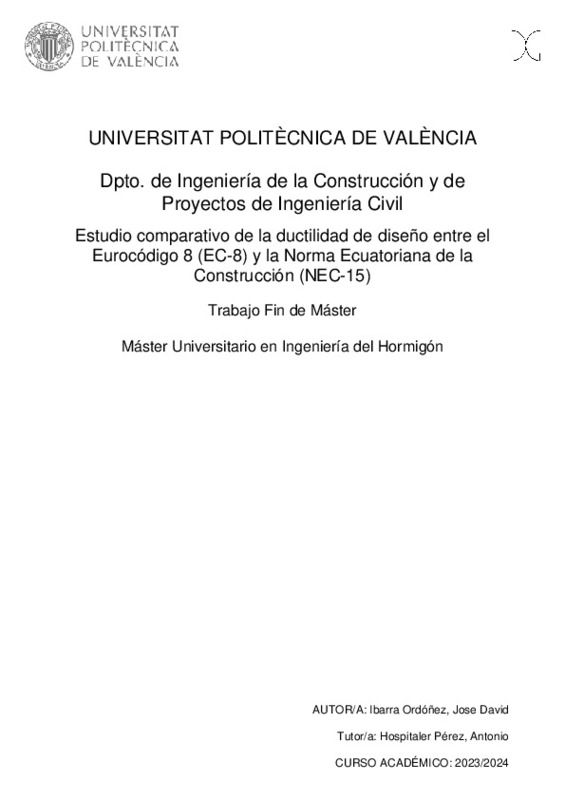Estudio comparativo de la ductilidad de diseño entre el Eurocódigo 8 (EC-8) y la Norma Ecuatoriana de la Construcción (NEC-15)
Mostrar el registro sencillo del ítem
| dc.contributor.advisor | Hospitaler Pérez, Antonio
|
es_ES |
| dc.contributor.author | Ibarra Ordóñez, José David
|
es_ES |
| dc.date.accessioned | 2024-04-11T09:23:38Z | |
| dc.date.available | 2024-04-11T09:23:38Z | |
| dc.date.created | 2024-03-27 | |
| dc.date.issued | 2024-04-11 | es_ES |
| dc.identifier.uri | http://hdl.handle.net/10251/203357 | |
| dc.description.abstract | [ES] Un diseño sísmico prestacional se lo realiza con el objetivo de precautelar la vida humana, evitando el colapso de las estructuras y reduciendo los daños y las pérdidas humanas, sin olvidar el coste económico, además con esto se obtiene un mejor comportamiento de las estructuras sin requerir un nivel de complejidad elevado. Con una buena ductilidad en las estructuras podemos llegar a cumplir con lo expuesto anteriormente ya que la ductilidad es la propiedad que tiene un material y en este caso elementos o estructura completa, para deformarse plásticamente antes de llegar a la ruptura, es decir que estos elementos son llevados a su máxima deformación antes de romperse. Es por esto que el objetivo general de este trabajo es comparar la ductilidad de un pórtico de una estructura convencional de 10 niveles, diseñado sísmicamente con la normativa europea, Eurocodigo 8 (EC-8) y la Normativa Ecuatoriana de Construcción (NEC-15). En primer lugar, se obtendrá el armado usando el programa CYPECAD, mediante un predimensionamiento de las secciones cuyo diseño estará acorde con todos los criterios sísmicos de cada una de las normativas entre las cuales se encuentra el periodo, control de derivas, etc., después mediante un Análisis Estático No Lineal (PUSHOVER) utilizando el software ETABS, se hallará la curva de capacidad de la estructura llevando al pórtico analizado hasta el punto de rotura. Teniendo así un último paso el cálculo de la ductilidad de diseño correspondiente a cada normativa, comparando los resultados obtenidos, así se e dará cumplimiento al objetivo general del trabajo de investigación. En este trabajo se ha pretendido conocer y aplicar de manera correcta todos los conocimientos de la ingeniería sísmica y poder afrontar nuevos retos de la construcción garantizando la seguridad de las personas. | es_ES |
| dc.description.abstract | [EN] A performance seismic design is carried out with the objective of protecting human life, avoiding the collapse of structures and reducing damage and human losses, without forgetting the economic cost, in addition to obtaining better behaviour of the structures without requiring a high level of complexity. With good ductility in the structures, we can comply with the above-mentioned, since ductility is the property that a material has and in this case, elements or complete structure, to deform plastically before reaching the rupture, that is to say, that these elements are taken to their maximum deformation before breaking. For this reason, the general objective of this work is to compare the ductility of a conventional 10-story structure portal frame, seismically designed with the European standard, Eurocode 8 (EC-8) and the Ecuadorian Construction Standard (NEC-15). First, the reinforcement will be obtained using the CYPECAD program, through a pre-dimensioning of the sections whose design will be in accordance with all the seismic criteria of each one of the regulations, among which are the period, drift control, etc., then through a Non-Linear Static Analysis (PUSHOVER) using the ETABS software, the capacity curve of the structure will be found, taking the analyzed portal frame to the point of rupture. The last step will be the calculation of the design ductility corresponding to each standard, comparing the results obtained, thus fulfilling the general objective of the research work. In this work, we have tried to know and apply in the correct way all the knowledge of seismic engineering and to be able to face new challenges of the construction guaranteeing the safety of people. | es_ES |
| dc.format.extent | 132 | es_ES |
| dc.language | Español | es_ES |
| dc.publisher | Universitat Politècnica de València | es_ES |
| dc.rights | Reserva de todos los derechos | es_ES |
| dc.subject | Análisis estático no lineal (Pushover) | es_ES |
| dc.subject | Hormigón armado | es_ES |
| dc.subject | Diseño sísmico | es_ES |
| dc.subject | Nonlinear Static Analysis (Pushover) | es_ES |
| dc.subject | Ductilidad | es_ES |
| dc.subject | Estructuras | es_ES |
| dc.subject | Ductility | es_ES |
| dc.subject | Structures | es_ES |
| dc.subject | Reinforced concrete | es_ES |
| dc.subject | Seismic design | es_ES |
| dc.subject.classification | INGENIERIA DE LA CONSTRUCCION | es_ES |
| dc.subject.other | Máster Universitario en Ingeniería del Hormigón-Màster Universitari en Enginyeria del Formigó | es_ES |
| dc.title | Estudio comparativo de la ductilidad de diseño entre el Eurocódigo 8 (EC-8) y la Norma Ecuatoriana de la Construcción (NEC-15) | es_ES |
| dc.title.alternative | Comparative study of the design ductility performance between Eurocode 8 (EC-8) and the Ecuadorian Construction Standard (NEC-15). | es_ES |
| dc.title.alternative | Estudi comparatiu del comportament de ductilitat de disseny entre el Eurocódigo 8 (EC-8) i la Norma Equatoriana de la Construcció (NEC-15) | es_ES |
| dc.type | Tesis de máster | es_ES |
| dc.rights.accessRights | Abierto | es_ES |
| dc.contributor.affiliation | Universitat Politècnica de València. Departamento de Ingeniería de la Construcción y de Proyectos de Ingeniería Civil - Departament d'Enginyeria de la Construcció i de Projectes d'Enginyeria Civil | es_ES |
| dc.description.bibliographicCitation | Ibarra Ordóñez, JD. (2024). Estudio comparativo de la ductilidad de diseño entre el Eurocódigo 8 (EC-8) y la Norma Ecuatoriana de la Construcción (NEC-15). Universitat Politècnica de València. http://hdl.handle.net/10251/203357 | es_ES |
| dc.description.accrualMethod | TFGM | es_ES |
| dc.relation.pasarela | TFGM\159903 | es_ES |
